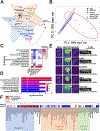Klebsiella pneumoniae induces host metabolic stress that promotes tolerance to pulmonary infection
- PMID: 35413274
- PMCID: PMC9081115
- DOI: 10.1016/j.cmet.2022.03.009
Klebsiella pneumoniae induces host metabolic stress that promotes tolerance to pulmonary infection
Abstract
K. pneumoniae sequence type 258 (Kp ST258) is a major cause of healthcare-associated pneumonia. However, it remains unclear how it causes protracted courses of infection in spite of its expression of immunostimulatory lipopolysaccharide, which should activate a brisk inflammatory response and bacterial clearance. We predicted that the metabolic stress induced by the bacteria in the host cells shapes an immune response that tolerates infection. We combined in situ metabolic imaging and transcriptional analyses to demonstrate that Kp ST258 activates host glutaminolysis and fatty acid oxidation. This response creates an oxidant-rich microenvironment conducive to the accumulation of anti-inflammatory myeloid cells. In this setting, metabolically active Kp ST258 elicits a disease-tolerant immune response. The bacteria, in turn, adapt to airway oxidants by upregulating the type VI secretion system, which is highly conserved across ST258 strains worldwide. Thus, much of the global success of Kp ST258 in hospital settings can be explained by the metabolic activity provoked in the host that promotes disease tolerance.
Keywords: Klebsiella pneumoniae; M2 macrophages; MDSCs; bacterial adaptation; disease tolerance; immunometabolism; immunosuppression; itaconate; pulmonary infection; type 6 secretion system.
Copyright © 2022 The Author(s). Published by Elsevier Inc. All rights reserved.
Conflict of interest statement
Declaration of interests B.R.S. is an inventor on patents and patent applications related to GPX4 and ferroptosis, a consultant to and co-founder of Inzen Therapeutics and Nevrox Limited, and a member of the Scientific Advisory Board of Weatherwax Biotechnologies Corporation. The other authors declare no competing interests.
Figures





References
-
- Ahn D, Bhushan G, Mcconville TH, Annavajhala MK, Soni RK, Wong Fok Lung T, Hofstaedter CE, Shah SS, Chong AM, Castano VG, et al. (2021). An acquired acyltransferase promotes Klebsiella pneumoniae ST258 respiratory infection. Cell reports, 35, 109196. 10.1016/j.celrep.2021.109196. - DOI - PMC - PubMed
Publication types
MeSH terms
Grants and funding
- T32 AI100852/AI/NIAID NIH HHS/United States
- S10 RR027050/RR/NCRR NIH HHS/United States
- R35 CA209896/CA/NCI NIH HHS/United States
- K08 HL138289/HL/NHLBI NIH HHS/United States
- K08 AI146284/AI/NIAID NIH HHS/United States
- R35 HL135800/HL/NHLBI NIH HHS/United States
- R01 CA140271/CA/NCI NIH HHS/United States
- R01 AI116939/AI/NIAID NIH HHS/United States
- P01 CA087497/CA/NCI NIH HHS/United States
- F30 CA265288/CA/NCI NIH HHS/United States
- R01 CA111289/CA/NCI NIH HHS/United States
- UL1 TR001873/TR/NCATS NIH HHS/United States
- R01 HD089935/HD/NICHD NIH HHS/United States
- R33 NS109407/NS/NINDS NIH HHS/United States
- K99 HL157550/HL/NHLBI NIH HHS/United States
- R61 NS109407/NS/NINDS NIH HHS/United States
- P30 CA013696/CA/NCI NIH HHS/United States
LinkOut - more resources
Full Text Sources
Molecular Biology Databases

